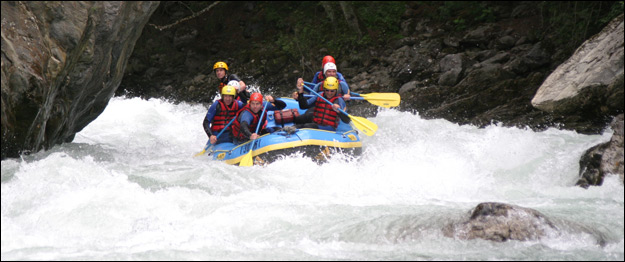
Whitewater Rafts
In the beginning all rafts were "bucket boats", so called because you needed a bucket to bail the water out after you had gone through the rapids. All that changed when Sotar invented the self bailing raft. For a few dollars more an inflatable floor, drain holes and pure physics lets all incoming water just flow out of the boat!
In Europe most companies use symmetrical paddle rafts. The rivers here are not as wide as in other parts of the world and the customers like to do something. In North America were rafting has evolved more as a private activity everybody wants to guide his own boat which has lead to a much higher use of oar rigs and the development of oar propelled catarafts.
Symmetrical Paddle Raft
This is a "normal" raft, it comes in different lengths and different widths depending on what you want to do with it. Because rafts were originally made in the USA all standard boat sizes are in feet. The most common sizes being 14 and 16 foot. Symmetrical boats also work a lot better than the old asymmetrical models which had problems reversing.
Oar Rigs
This boat is exactly the same as the symmetrical paddle raft with a oar frame attached to it. This means that only one person is needed to row the raft through the rapids. On a multi day trip oar rigs are great for transporting large amounts of food and equipment. You can combine a oar rig and paddle boat on hard runs to get a bit more power. This can either be set up as a center mount or as a stern mount whichever the guide prefers.
Cataraft
The main problem with rafts is that when they hit a hole, as they have so much buoyancy and surface area, they stop dead and then flip or end up surfing. The Russians came up with the solution of less being more. Catarafts due to there smaller surface area penetrate holes much better than normal rafts and are great for highline rescue work. However catarafts can't be heavily loaded as they have much less buoyancy for the same size of boat. Catarafts can beset up either as paddle cats or Oar cats.